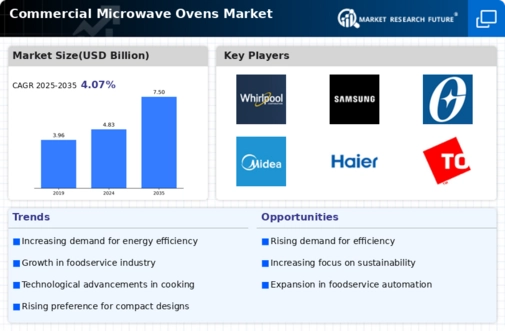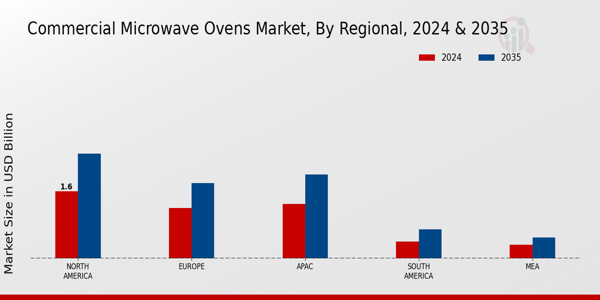Market Growth Projections
The Global Commercial Microwave Ovens Market Industry is projected to witness substantial growth over the coming years. With an anticipated market value of 4.83 USD Billion in 2024 and a forecasted increase to 7.5 USD Billion by 2035, the industry is on a promising trajectory. This growth is supported by various factors, including technological advancements, rising demand from the food service sector, and an increasing focus on energy efficiency. The compound annual growth rate (CAGR) of 4.08% from 2025 to 2035 indicates a robust market environment, reflecting the ongoing evolution of cooking technologies and consumer preferences.
Rising Focus on Energy Efficiency
The Global Commercial Microwave Ovens Market Industry is increasingly influenced by the rising focus on energy efficiency. As businesses seek to reduce operational costs and minimize their carbon footprint, energy-efficient microwave ovens become a preferred choice. These models often utilize advanced insulation and inverter technology, which not only conserves energy but also enhances cooking performance. The growing awareness of sustainability among consumers and regulatory bodies further propels this trend. As a result, manufacturers are likely to invest in developing energy-efficient solutions, thereby contributing to the market's projected compound annual growth rate (CAGR) of 4.08% from 2025 to 2035.
Expansion of Food Delivery Services
The expansion of food delivery services significantly impacts the Global Commercial Microwave Ovens Market Industry. As more consumers opt for convenience, restaurants and food service providers increasingly rely on commercial microwaves to quickly prepare and reheat meals for delivery. This trend necessitates efficient cooking equipment that can handle high volumes without compromising food quality. The rise of delivery platforms has prompted establishments to optimize their kitchen operations, leading to a higher demand for commercial microwaves. Consequently, this shift in consumer behavior is likely to sustain market growth, as businesses adapt to meet the evolving needs of their clientele.
Growing Demand for Quick Service Restaurants
The Global Commercial Microwave Ovens Market Industry experiences a notable surge in demand driven by the expansion of quick service restaurants (QSRs). These establishments prioritize speed and efficiency, necessitating equipment that can deliver rapid cooking solutions. With the market projected to reach 4.83 USD Billion in 2024, the reliance on commercial microwaves for reheating and cooking menu items becomes increasingly evident. QSRs often utilize these ovens to maintain food quality while minimizing wait times, thus enhancing customer satisfaction. As the QSR sector continues to grow, the demand for commercial microwave ovens is likely to follow suit, reinforcing their critical role in food service operations.
Increasing Adoption in Institutional Settings
The Global Commercial Microwave Ovens Market Industry sees a growing adoption of microwave ovens in institutional settings such as schools, hospitals, and corporate cafeterias. These environments require efficient cooking solutions to cater to large groups while ensuring food safety and quality. Commercial microwaves provide a practical solution for reheating meals quickly, thus supporting the operational efficiency of these institutions. As the demand for convenient meal options rises, the integration of commercial microwaves into institutional kitchens is expected to increase. This trend not only enhances service delivery but also aligns with the broader movement towards modernizing food service operations.
Technological Advancements in Microwave Technology
Technological innovations play a pivotal role in shaping the Global Commercial Microwave Ovens Market Industry. Recent advancements include the integration of smart technology, which allows for precise cooking and energy efficiency. These innovations not only improve the cooking process but also reduce operational costs for businesses. For instance, some modern commercial microwaves feature programmable settings that cater to diverse menu items, enhancing versatility. As the market evolves, the introduction of energy-efficient models is expected to attract environmentally conscious businesses, further driving growth. The anticipated increase in market value to 7.5 USD Billion by 2035 underscores the importance of these technological advancements.


























Leave a Comment